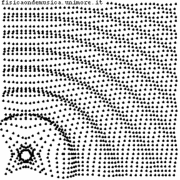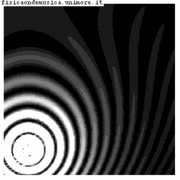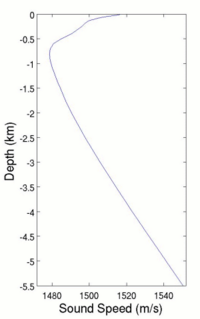Rifrazione del suono en
Da "Fisica, onde Musica": un sito web su fisica delle onde e del suono, acustica degli strumenti musicali, scale musicali, armonia e musica.
Jump to navigation Jump to search- Sound is a wave, and as such, is subject to the phenomenon of refraction. This means that a sound wave changes propagation direction when it crosses regions in which it propagates with different speeds. Naturally, refraction also occurs when sound passes from one medium to a different one.
- To precisely calculate the change of direction, we must know how the speed of sound changes when the nature and properties of a medium change. For this topic, please see the dedicated section on the speed of sound, while, in the following sections, we will examine several situations in which sound refraction plays an important role.
Sound refraction in air
Due to gradients of temperature
Constant gradient
- The speed of sound in a gas of fixed composition and at equilibrium depends only on (the square root of) its temperature (see the sections on the speed of sound and equation of sound waves for details).
- The general tendency of air temperature in the atmosphere is to diminish with altitude: the higher up, the colder.[1]
- For example, let's consider a sound wave that leaves from the ground. The wave irradiated from a point is initially spherical.
- When its front reaches a sufficient height, its speed decreases while the part of the wave that is propagating at a lower height continues to propagate with the same speed.
- Therefore, the net result is that the front curves upward.
- Consequently, it is possible that, on the ground at a certain distance from the source, the sound is not heard at all. The sound "rays" have been deflected upwards by refraction.
- Below is an animation of the phenomenon, which you can also experiment with using the 2D Wave Applet (see mirages and other strange phenomena)
| waves | intensity |
|---|---|

|

|
| spherical sound waves in air with a refraction index that increases with altitude (normal atmosphere) | |
- There are situations in which thermal inversion occurs, such as in the summer during a clear night after a hot day.
- The ground can rapidly lose heat due to radiation and the air can be colder nearer to the ground than at a higher altitude.
- Waves emitted from a sound source on the ground will be slower near to the ground than high above and their wave fronts will curve towards the ground.
- In this situation, sound can reach points that it could never have reached in constant temperature conditions and can be heard much further away.
- Below is an animation of the phenomenon, which you can also experiment with using the 2D Wave Applet (see mirages and other strange phenomena)
| waves | intensity |
|---|---|

|

|
| spherical sound waves in air with an a refraction index that decreases with altitude (atmosphere with thermal inversion) | |
Irregular gradient
- Have you ever noticed that when the noise of an airplane engine reaches us, it is often irregular and inconsistent even if the airplane is travelling uniformly?
- This effect can be explained by the refraction phenomenon recalling that, for sound to reach the ground, an airplane must pass through often turbulent air masses at different temperatures. This phenomenon is exactly the same, even if on a different scale, as the phenomenon of twinkling stars, which occurs due to refraction of light rays in the atmosphere.
Due to wind
the experience of faraway sounds "carried by the wind" is quite common. What is less common, is to realise that the nature of this phenomenon is not "transport" but refraction. Let us look at why.
- First of all, we observe that a uniform wind has substantially no effect on sound. It cannot "carry it" for the simple reason that sound generally propagates at a much greater speed than the wind. Sound in air travels at a speed of about 1,200 km/h, while the wind, in normal conditions, has speeds ranging from 100 to 1,000 times slower and can reach a speed of minimum 10 times slower only during hurricanes (during which the noise drowns out all sounds),
- The intensity of the wind is on average less closer to the ground than far from the ground due to friction and the obstacles close to the ground.
- A horizontal "sound ray" that propagates downwind is bended downwards, while one that propagates upwind is deflected upwards.
- This causes a situation qualitatively similar to the case of the thermal gradient. Sound that propagates downwind corresponds to that which propagates in a thermal inversion and it is able to travel further.
Sound refraction in water
- The temperature of water in the seas and oceans also varies with depth.
- Therefore, it is clear that sound is also refracted in water. This fact is of fundamental importance to animals or watercrafts that use sound waves for navigation.
- In fact, by deviating sound waves from their rectilinear path, refraction can concentrate or diverge them exactly like lenses do with electromagnetic waves creating acoustic illusions that trick (either artificial or natural) sonar. Furthermore, water temperature can experience abrupt local variations due to the presence of thermal currents.
- Even if we neglect local variations, there is an important difference between water and air: water is incompressible and, therefore, its pressure contributes to changing the speed of sound at great depths [2].
- Therefore, the effects of temperature are more evident close to the surface, while the effects of pressure are more significant with depth.
- The result is that the speed of sound in the ocean as a function of depth first decreases but then, once it has reached its minimum value increases to its maximum value at the bottom.
- Since, as we have said above, sound waves are bent from the region where sound is the fastest to the region where sound is the slowest, consequently, ocean sounds tend to be conveyed into a "channel" in which the speed of sound has a minimum value.
- Therefore, refraction creates a privileged underwater channel (let's say a natural wave guide) that allows sound to propagate underwater at great distances.
- This channel, called SOFAR (SOund Fixing and Ranging), is located at a depth of 600 to 1,200 m at average latitudes, is deeper at the tropical latitudes and shallower at higher latitudes.
Sound refraction at the air-water interface
In the two preceding paragraphs, we have examined sound refraction separately in the two media of air and water more or less due to the presence of thermal gradients. Now we ask, what happens when sound generated in the air hits a water surface? Or vice versa, are sounds produced in water audible outside it?
- We know that the speed of sound is greater in water than in air (by about 4.5 times), therefore, it is logical to expect that sound waves passing between air and water will behave oppositely to light waves. In particular, light waves tend towards normal, while sound waves tend away from it.
- The analogy is correct but precise calculations lead to a very qualitatively different conclusion!
- In fact, we must consider that the two media also have different densities: that of water is about 1,000 times greater than that of air. This fact makes it extremely difficult to transfer elastic energy from air to water and vice versa through sound waves. It is said that the impedances of the two media are not matched. Our auditory system is an excellent means for impedance matching and transferring sound wave energy to the liquid of the cochlea.
- Therefore, when a sound produced in the air hits water, or vice versa, the wave is completely reflected (see reflection and refraction)!
- A similar phenomenon occurs with light that is below the critical angle for total reflection. This angle, for sound generated in the air and aimed at a water surface, is only 13°. Even below this angle, transmission is very weak.
- Therefore, it is not possible to frighten fish by screaming outside the water! The situation is different if you have your feet in the water because your body functions like an impedance adapter and can transmit part of the vibrations (unfortunately, we do not have any relative quantitative data).
Sound refraction at the air-human body interface
The conclusion that we have arrived at regarding the passage of sound waves between air and water is also valid for when sound passes from air to a human body, which has a similar density to water. The transmission coefficient is very low.
- Just a minute! Then why does sonography work?
- Have you noticed that before applying the sonograph source to a patient, a mysterious gel is spread on the contact area? Well, that gel serves to match the impedance of the ultrasound emitter to that of the human body allowing the ultrasound to propagate internally. Visit this page, if you want further information on sonography techniques.
Virtual laboratory
- To visualise and follow the refraction phenomenon "live" in its time evolution in various configurations, use the applet on the 2D Wave Applet page.
- You can also do several step-by-step, guided experiments by following the instructions on the Virtual laboratory: experiments on refraction page.
In-depth study and links
- The site Ocean Explorer of the NOAA (National Oceanic and Atmospheric Organization) of the United States government has a lot of interesting news on ocean acoustics and includes numerous articles and collections of marine videos and sounds.
- ↑ At equilibrium in ideal conditions, we can demonstrate that the thermal gradient is given by the formula , which corresponds to a diminution of one degree centigrade for each 100 m of altitude.
- ↑ Let's recall that for incompressible liquids, pressure increases linearly with depth (Stevin's law). Specifically, pressure increases by about one atmosphere per every 10 metres of depth
Categoria:



